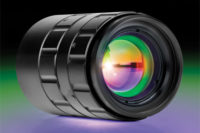ANN ARBOR, MI - The GigE Vision camera interface standard that has been used by the machine vision industry since 2006 has recently been updated and Version 1.2 is now available. The GigE Vision standard committee worked diligently to improve the standard and version 1.2 brings brand new features, such as control of non-streaming devices to the industry. The Automated Imaging Association (AIA), the trade group that represents the global machine vision and imaging industry, oversees the ongoing development and administration of the standard.
GigE Vision is a camera interface standard developed using the Gigabit Ethernet communication protocol. GigE Vision allows fast transfer (1000 Mbps) of data using low cost standard cables over very long lengths (up to 100 meters). With GigE Vision, hardware and software from different vendors can interoperate seamlessly over Ethernet connections.
Version 1.2 introduces non-streaming device control to the popular standard. It accommodates networked video distribution applications that leverage switched Ethernet client/server video networks. Devices such as GigE Vision-enabled lights will now be automatically recognized by the computers on the network.
“Version 1.2 is a major milestone for GigE Vision as it opens the doors for new classes of products beyond the traditional camera. It enables the integration of various types of devices through a common control protocol, greatly simplifying software development for system integrators. This demonstrates the direction GigE Vision is taking to be more than a simple camera interface by providing a complete networking model to machine vision,” says Eric Carey, chair of the GigE Vision standard committee and R&D director at Dalsa Corp.
GigE Vision is a widely adopted interface, with dozens of leading companies offering hundreds of GigE Vision compliant products in the market today. GigE Vision should not be confused with devices that only say they are “GigE,” while a GigE device may use Ethernet connectivity, it does not use the GigE Vision communication protocol and will not plug-and-play with GigE Vision compliant devices. Expect to see growth in the GigE Vision compliant products on the market such as hardware-based video receivers, software-based video servers andnetwork controlled devices. The highly scalable interface will follow the rapid growth of Ethernet bandwidth. The GigE Vision standard committee is already at work on GigE Vision 2.0 with an expected release in mid-2011.
“The Committee remains focused on maintaining and improving the industry leading features of the GigE Vision standard. I am especially grateful to Vincent Rowley, our committee vice-chair and senior system designer at Pleora Technologies, for leading the team effort to get Version 1.2 to the market,” says Jeff Fryman, AIA’s director of standards.
GigE Vision Standard Version 1.2 Released
Looking for a reprint of this article?
From high-res PDFs to custom plaques, order your copy today!




